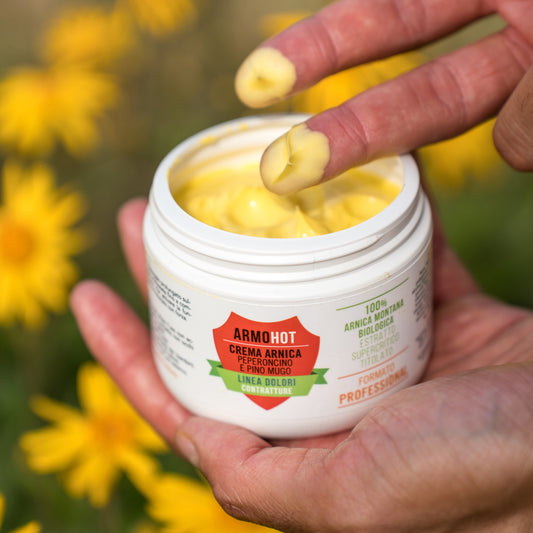Mountain Arnica is a medicinal plant with well-known pain-relieving, analgesic, anti-inflammatory and anti-ecchymotic properties. The populations of the European Alps have always used mountain Arnica as a natural remedy, especially for traumas and muscle and joint pain. It is no coincidence that one of its names is Fallkraut, which in German means "fall grass".
But let's see in detail everything we need to know about this plant.
Botanical description
Mountain Arnica (Arnica montana L.) is a rhizomatous herbaceous perennial species belonging to the Asteraceae family, it is 20 to 60 cm high.
The basal leaves are lanceolate and cross-shaped. The stem erects singularly or with 1-2 pairs of opposite branches along with 1-2 pairs of cauline leaves. The paired leaves on the stem are one of the characteristics that clearly distinguish it from other species of the same family and that the inexperienced hiker may confuse.
The flower heads have external ligulate female flowers and internal tubular hermaphrodite flowers, while the fruits are blackish, pubescent achenes surmounted by a small yellowish feathery pappus. Arnica emits a characteristic scent that can be used to distinguish the plant from other mountain plants with similar flowers even after it has withered.

Species and origins
The Arnica genus consists of 32 species worldwide, belonging to the Asteraceae family. Species of this genus inhabit the northern hemisphere, especially mountainous and circumboreal areas. The maximum diversity of the species is found in western North America, while in Asia it is found in the northern part, in the north of the Himalayan ranges. In South America its presence is considered as naturalised.
Mountain Arnica, on the other hand, is endemic in Europe, from the Iberian Peninsula to Scandinavia and the Carpathians, while it is totally absent in the British Isles. In Italy, it grows wild in the Alps and the Tuscan-Emilian Apennines at an altitude which goes from 800 to 2200 metres. It is easily recognisable during the summer season by its orange-yellow flowers, it grows on meagre, nutrient-poor soils, in rhododendron moors and dry meadows.
Mountain Arnica is often substituted in medicinal preparations by Arnica chamissonis, its American sister species, which is easier to find but poorer in active ingredients. It is even easier for many formulators to use extracts of Heteroteca inoluloides, commonly called Mexican Arnica, a plant growing in Mexico which vaguely resembles Arnica but does not even belong to its genus.
Natural habitats and the risk of extinction
Mountain Arnica is an undemanding plant that grows mainly in the middle and high mountain regions. It prefers acidic (pH 3.5-6.5), poor, loamy, moist but well-drained soils. It avoids nutrient-rich, chalky soils. The ideal habitats are well-exposed, unfertilised mountain meadows, coniferous forests, and dry heathlands. It is assumed that the marginal areas of heathland and the subalpine zone are its original primary locations.
As one of the world's most widely used medicinal herbs, its growing demand on the market has led to exploitation of the natural habitats where this plant has always grown wildly, putting the survival of this species at serious risk. According to the IUCN (International Union for the Conservation of Nature), mountain Arnica is not yet threatened on a continental scale, but in many European countries the population is declining, and in some cases, it is completely or almost extinct.
In addition to massive harvesting of the wild plants, other causes of the progressive disappearance appear to be climate change and the consequent loss of suitable habitats, the eutrophication through fertilisation, the spreading of competitive plant species and the reduced genetic exchange among the increasingly isolated populations.
 Attempts to safeguard the species
Attempts to safeguard the species
Efforts which are being made in some European countries to protect populations include the late mowing of meadows, extensive grazing to preserve the open spaces (Arnica itself is despised by grazing animals because it is toxic), the restoration and the optimisation of the meadows where Arnica was previously present and the creation of buffer strips to reduce nutrient inputs.
Cultivation, on the other hand, is still underdeveloped, a practice that has been discussed for many years but is struggling to take hold. The low germinability of the seed, the high plant mortality, the unpredictable productivity due to the variability of soils and seasons, and the very high costs of running an organic crop discourage potential growers.
What is being done in Europe
A real trial of mountain Arnica cultivation was carried out in Romania, which is one of the main sites for the harvesting of the wild species, and the results seem to have been encouraging (source KräuterABC). Instead, the resettlement trials of the species have been carried out in Germany in the Lower Saxony forests, thanks to a cooperation project between the state forest management authority and some universities (source: lifePR).
In France, more precisely in the Ballons des Vosges Natural Park, another important mountain Arnica supply site, the collection of the wild species has long been regulated following the Markstein Convention. However, this agreement, which imposes strict harvesting parameters, does not seem to be enough to counteract the drastic decline of Arnica from the French meadows (source L'Est Républicain).
The most significant example of mountain Arnica cultivation known in Europe today is ours. At ARMO1191, our aim is to cultivate this plant so that everyone can benefit from its extraordinary properties. In this way, by not collecting wild specimens from our mountain meadows but using our own cultivated specimens in our products, we try to encourage genetic exchange so that the species can reproduce and survive.

The medicinal properties of mountain Arnica
The substances that mostly characterise mountain Arnica are the sesquiterpene lactones contained in its flowers. Among these, analgesic and anti-inflammatory properties are attributed to Helenalin and, to a lesser extent, Dihydrohelenalin.
Studies show that the presence of these molecules is influenced by the climate, the altitude and the harvesting time, the cultivar planted and the variability of the wild populations.
In addition to the sesquiterpene lactones, as many as 150 active therapeutic substances present in Arnica, such as flavonoids, essential oils, carotenoids and caffeic acid have been identified to date. Mountain Arnica is known for its numerous assets, including those referring to its anti-tumour, anti-fungal, anti-bacterial and antioxidant ones.
However, a serious obstacle to the development of Arnica based medicines is the toxicity of the plant if ingested, particularly of the helenalin contained. Arnica is widely used for internal use only in homeopathy, provided it is widely diluted.
For external topical use, there are no specific contraindications, apart from the recommendation to not use it on injured skin or bleeding wounds.
 The field and the form of use of the mountain Arnica preparations
The field and the form of use of the mountain Arnica preparations
For external topical use, studies confirm that mountain Arnica helps with bruises, sprains, swelling due to fractures, contractures, strains, fatigue, muscle, and joint pain, as well as insect bites, furunculosis and phlebitis.
A plant extract based on mountain Arnica can be used for the preparation of creams, gels, oils, tinctures, and ointments. It is important to know how the plant was extracted, the solvent used (oil, alcohol, supercritical fluid, water) and the parts used (the greatest concentration of active principles reside in the flower heads) to define the efficacy of the preparation.
Titration, that is the analysis that determines the concentration of the active principle which is expressed within the extract is a fundamental procedure that establishes the quality standard of an extract.

The origin of its name
The name Arnica probably derives from the Greek ptarmike=sneeze because the root and flowers provoke "sneezing", they contain substances capable of irritating the nasal mucosa, therefore causing repeated sneezing. In both the Venetian and Lombard dialects, it was known as “erba starnudela-sneezing herb”.
There are many vernacular names for Arnica: from "blessed herb of the mountains" to "fall herb" to "mountain tobacco" or "Vosges tobacco". In fact, on the French massif, where it grew wild in large quantities, the dried and pulverised leaves were often used by mountain dwellers as snuff or pipe tobacco.
 Historical background
Historical background
Although traces of Arnica flowers have been found in an eye ointment in a Roman tomb in Cologne, the first written records of this plant date back to the Middle Ages. It was Hildegard of Bingen, a Benedictine nun who lived between 1098 and 1179, who first mentioned this plant in her work Physica under the name of Wolfsgelegena.
Hildegard, however, was not yet aware of the curative properties of Arnica but believed it to have magical virtues. She wrote: "When a man or a woman is burning with love for someone, if they touch him or her on the skin with Arnica, then he or she will also burn with love for them. And when the herb dries up, then the man or the woman almost become insane with the fire of love, so insane that they eventually go out of their minds".

The name Arnica appears for the first time in the writings of the French botanist Carolus Clusius in 1583, in his treatise on the Austrian and Hungarian Alpine flora Pannonias observatorum Historiae. By the end of the Middle Ages, the healing properties of this plant were widely known. Arnica had become a natural remedy, especially in mountainous areas where it was easy to find.
Other indications of the uses of this plant come from Goethe (1749-1832), who in his autobiography Poetry and Truth, tells us that against the heart cramps from which he suffered he regularly had a tisane made from Arnica.
Arnica in the folk tradition
At a time when the medicinal properties of plants could not be explained scientifically, people believed in their mystical powers. This is evidenced by some of the old names by which Arnica was called, such as 'wolf flower', 'thunder flower' or 'angel grass'.
As the shape of its flowers was believed to represent the sun, the plant also played an important role in many popular customs related to the summer solstice and St John's Day, on the 24th of June.
It was on this date that the ancient Germans celebrated the marriage of the Sun god with the Earth goddess, so that the summer harvest would be abundant (only later did astronomers discover that the summer solstice falls more precisely on the 21st of June). The Arnica harvested on that day was also said to have special healing properties.

Another popular custom was to place bunches of Arnica in the corners of the wheat fields the evening before St John's Day. The farmers thus kept away the wheat demon, who was said to roam the fields on the nights of the summer solstice, cutting the ears of the wheat and destroying the harvest.








